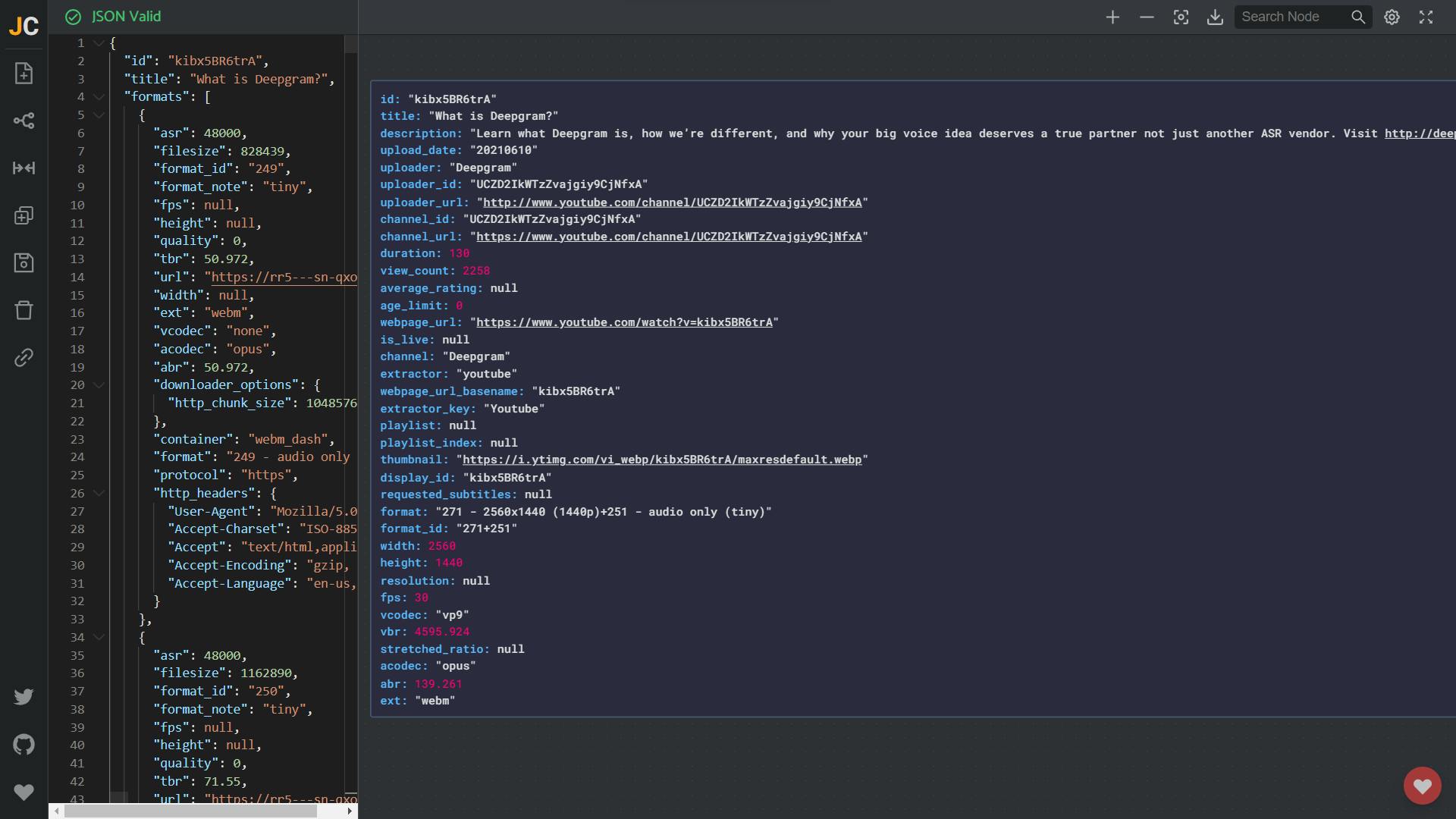I'm still learning and building. This article is still in beta. I'm trying to optimize, enhance, refactor and more to work on.
YouTXT is an app that transcribes any YouTube videos and provides users with various features to do with the transcribed text.
Let's get started!
What we will be using?
Deepgram - It gives developers the tools they need to easily add AI speech recognition to their applications. We need API, so sign up here and get ~200 hours of free transcription.
OpenAI - It provides a range of artificial intelligence services, including machine learning, natural language processing, and computer vision. We will be using it only to extract the keywords in the video. Maybe we will use its power to level up the project later.
Streamlit - It allows you to quickly create and share beautiful, interactive data visualizations and applications in pure Python.
And we need some packages which we will see ahead.
Let's code it out!
We will try to build it piece by piece!
Extract audio from YT Video
Send the audio to Deepgram and get the transcription
Extract keywords using OpenAI
Translating the Transcript
Building UI with Streamlit
Extract audio from YT Video
For this process, we need youtube-dl package that allows us to download videos from youtube.com
pip install -U youtube-dl
Here's EMBEDDING YOUTUBE-DL documentation
We will get the YouTube video URL from the user and pass it to the function where the download takes place.
First let's extract the info of the video to be downloaded.
import youtube_dl
video_url = "https://youtu.be/kibx5BR6trA" # Any YT URL
videoinfo = youtube_dl.YoutubeDL().extract_info(url = video_url, download=False)
print(videoinfo)
With the extract_info function we will get the response as follows:

It's quite large to visualize but anyway, all we need is the id and webpage_url. If you like to visualize the JSON output, check out jsoncrack.
We will create a file named based on their video ID.
videoinfo = youtube_dl.YoutubeDL().extract_info(url = video_url, download=False)
filename = f"{videoinfo['id']}.mp3"
options = {
'format': 'bestaudio/best',
'keepvideo': False,
'outtmpl': filename,
}
with youtube_dl.YoutubeDL(options) as ydl:
ydl.download([videoinfo['webpage_url']])
base = Path.cwd()
PATH_TO_FILE = f"{base}/{filename}"
Let's Transcribe
First, install Deepgram with pip
pip install deepgram-sdk
Next, we should import the Deepgram client in our application code:
from deepgram import Deepgram
For the initialization part, let's create a single instance of the deepgram client
dg_client = Deepgram(DEEPGRAM_API_KEY)
Now with the help of Deepgram's Official Python SDK, we will transcribe our downloaded file.
from deepgram import Deepgram
import asyncio, json
DEEPGRAM_API_KEY = 'YOUR_API_KEY'
PATH_TO_FILE = 'some/file.wav'
async def main():
# Initializes the Deepgram SDK
deepgram = Deepgram(DEEPGRAM_API_KEY)
# Open the audio file
with open(PATH_TO_FILE, 'rb') as audio:
source = {'buffer': audio, 'mimetype': 'audio/wav'}
response = await deepgram.transcription.prerecorded(source, {'summarize': True, 'punctuate': True, "diarize": True, "utterances": True })
# st.json(response, expanded=False)
response_result_json = json.dumps(response, indent=4)
asyncio.run(main())
The above code initializes the Deepgram SDK and then opens the audio file. It then transcribes the audio file and gives us the result in JSON format. We will process it to show the results.
Extract Keywords
This is an example from the OpenAI - Extract Keyword
import os
import openai
openai.api_key = os.getenv("OPENAI_API_KEY")
response = openai.Completion.create(
model="text-davinci-002",
prompt="enter the text here",
temperature=0.3,
max_tokens=60,
top_p=1.0,
frequency_penalty=0.8,
presence_penalty=0.0
)
Translate the Transcript
For this we need a package called itranslate which helps us to translate the transcript to different languages as selected by the user. As always install the package
pip install itranslate
To use the package, we need to import the package in our code. Below is the basic example of how to translate the text using itranslate. In the place of text, send in the transcription. For the to_lang param, we will use the st.selectbox which allows the user to choose which to which language needs to be converted.
from itranslate import itranslate as itrans
itrans("test this and that") # '测试这一点'
# new lines are preserved, tabs are not
itrans("test this \n\nand test that \t and so on")
# '测试这一点\n\n并测试这一点等等'
itrans("test this and that", to_lang="de") # 'Testen Sie das und das'
itrans("test this and that", to_lang="ja") # 'これとそれをテストします'
Building UI with streamlit
If you are new to streamlit, check out You can just turn data scripts into apps! to get started.
With the help of data that we have, we will build the UI using streamlit API. The tools are simple and self-explanatory. Check out the API Documentation
References/Docs
Project URLs
Created for Learn Build Teach Hackathon 2022
